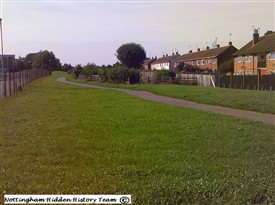Chilwell: An Early Garden Suburb

Area near to Eskdale Drive
Nottingham Hidden History Team
By Joseph Earp
In a few years time, Chilwell will be part of the new tram route. The line will cut right through the heart of the Chilwell Inham Nook Estate. It is planned that the line from Beeston will go down Chilwell Road and by South Nottingham College. After the College stop the line will turn right (Northwest) on to a new reserved route, following the route of a stream, through residential areas of Chilwell. There will be stops at Cator Lane, Eskdale Drive, with a penultimate stop at Inham Road. The line will then terminate at Toton Lane Park and Ride Tram Stop.
Most of the area within Chilwell where the tram route is going belonged to the Pearson family who were horticulturists. The area was once well known for its beauty. Someone once said that all you could see in Chilwell was field after field of orchards and flower beds.
It all started with John Pearson, who was then in the hosiery trade, he was a very keen amateur florist. It is said that one day at Derby whilst visiting a show, Pearson purchased a pair of Carnations in large pots and he feared that they would be changed if he left them where they were. It is reported that he left his horse at Derby and walked eleven miles, carrying a large pot under each arm. He then walked back to Derby to fetch his horse.
His love of flowers led him to turning his passion into a successful business. He inherited the old Chilwell Manor House, with an orchard attached. Later on, he purchased land wherever he could and planted about one hundred acres of orchards. The orchard was the largest sweet apple orchard in the country at the time.
The family also developed the growth of roses, chrysanthemums and other flowers in glasshouses. The Directory for 1832 names ‘the extensive nurseries kept by Mr. John Pearson’. Pearson eventually removed from Chilwell to Lowdham in Nottinghamshire. However Pearson certainly left his mark in the area. Most of Pearson’s orchards and flower fields continued to be used right up until the mid 1960’s.
My Grandparents moved to Chilwell in 1967 just as the area was being developed into housing estates. My Grandparents and Mum lived at the top of Greenland Crescent. My Mum recalls when they moved there in 1967, much of the area was still orchards and flower beds. At the back of their house (Oakdale Drive, Field Lane area) were rose fields and they were still being worked.
Eventually all of the old orchards were removed for the Inham Nook Estate. The estate was built by Beeston and Stapleford Urban District Council. Many of the old orchards and fields were compulsory purchased. John Royston Pearson’s presence in the area is still felt, with roads such as Pearson Avenue, Elm Avenue, Oak Acre and Field Lane.
It is interesting to note that the Chilwell Ghost House or Ash Flat House was also at one time owned by John Pearson. Many people know of the Chilwell Ghost from Alan Dance’s excellent book. The original ‘Ghost House’ was a small cottage which was on a small lane which led to Stapleford. The house was located at the bottom of the hill within an orchard. The tram will cut right through were the house and orchard once stood, this is roughly where Ghost House Lane and Eskdale Lane now stand. When the workmen who will lay the tack for the tram, dig up the area, will they find the body of the murdered pedlar and finally solve the case of the Chilwell Ghost?
Article by the Nottingham Hidden History Team.